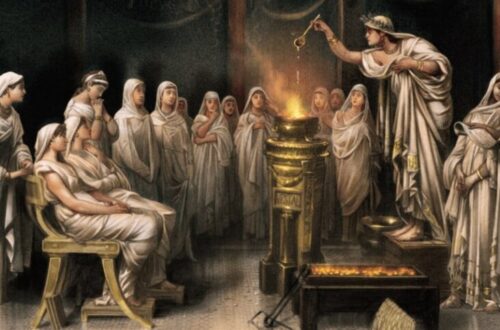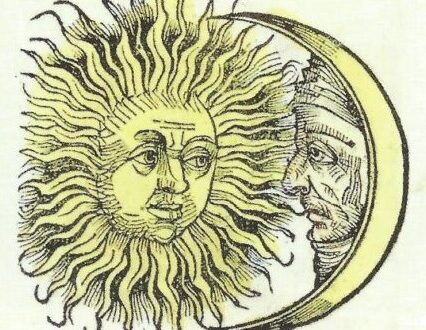
The Almanac, Galileo and the Precession Jolt

The Almanac was born in Germany in the 15th Century, promoted by the printing industry. George Peurbach’s Yearbook (1460) in Vienna is considered the first German almanac. Handwritten almanacs were more prepared for personal use. Older than Peurbach’s Almanac are several Arabic manuscripts with similar information about stellar sunrises, weather, and with many references to work in agriculture and seafaring. They are based on an ancient Arabic – Pre-Islamic – astronomy system that, in the course of the year has 28 ‘stars’ known as ‘Nau’, each a period of 13 days and assign certain weather attributes to each of these periods. The plural Al-Anwa’ is used for the system. During the 13 days of a particular star it is a ‘leading’ star and each is paired with another, known as an ‘observer’ (Raqib) that rises when the other goes down. There were attributes for each Nau, which related to the wind and rain, much like a modern farmer’s calendar.
One would expect of such an almanac that information concerning the beginning of Spring or the duration of a season should be astronomically correct and the dates to be right in some particulars, if the Almanac is not to be worthless.
The Almanac of Ibn ‘Asim from Cordoba, (Kitab alAnwa’ wa alAzmina), written perhaps “in the year 1000 AD”, was examined in detail by Miquel Forcada Nogués in Arabic and in a version published in Spanish (Barcelona 1993), in order to get an impression of this kind of literature. The manuscript comes from Istanbul and was copied, according to the text on the first page, in the year 497 Hegira (equiv. to 1104 AD). Although it is not entirely clear who the author and copyist were, says Forcada, one facsimile print (F. Sezgin, Frankfurt/M 1985) used, a barely-known chronicle, suggests that a man of the famous house of Ibn ‘Asim, Abd Allah ben Husayn, known as Ibn al-Gurbali, compiled the text, but he almost always mentions his sources. It is the only manuscript of this book. The rich mixture of information that is contained therein also has some literary entertainment value (just like our current almanacs).

According to Forcada, the Almanac of Ibn ‘Asim meets several objectives: it aims to provide independent thought, then the original (pagan) heavens and pass on weather traditions of pre-Islamic Arabs, and it needs to support the weather forecast and calendar for ordinary people in Andalusia. In addition to the clear ideological orientation, therefore, the utility of the book has also been emphasized. Mixing the pagan tradition with the classic Hellenistic is sometimes confusing. Otherwise, the calendar is a hotchpotch of information that is of varying value. As an example, I mention a brief excerpt from the month of October. After extensive notes about the constellations, the moon houses, and the weather records comes this: “It mentions that on the second day of this month, the Nile in Egypt again subsides. That same month, one reaps in Trujillo (southwestern Spain) and sows at Cadiz, and on its twentieth day even those near Cordoba reap, having made an early start with the sowing. On the eleventh day, the sea is wild and the ships do not go out. The vulture and the swallows are retreating to their burrows and the ants hide themselves. In this month one measures the yield of the olives and begins the harvest, and one states that it becomes cold. … “

The supposed utility of these statements is, in my opinion, equal to zero. If the calendar is filled with any meaning, then it is an astronomical one. Even as a calendar of festivals, it is too sparse: It shows the Egyptian New Year (with the Persian name, Nauroz), erroneously, on 20th instead of on 29th August (slip of the pen?), and the feast of St. John the Baptist, the son of Zacharias, “Peace be with them” (father and son are revered in Damascus and Aleppo in Syria) on 24th June, which is correct. Of the many saints that are listed, for example, in the Calendar of Cordoba of ‘Arib ben Sa’id, there is not a word.
The Calendar of Cordoba is mentioned nowhere by Ibn ‘Asim, although some information is a literal match. We may assume that this work, dated about the same time, used the same source. (Dozy made famous the Roman Catholic Calendar of Cordoba, which I think is a late production of the Spanish church, see my lecture 1998.) The pre-Islamic Arabs divided the year into two halves: rainy season (winter) and hot (summer). Thus, it is still in the Qur’an (surat 106), and it is repeated by many astronomers. The almanacs are differentiated, they divide the two half years again so that the four seasons occur, spring and autumn are added. The beginning of each quarter is not always exactly at the beginning of the month, and the solstices are not always accurate and on the same day, but because so many factors are to blame, we can say grosso modo: their calendar is correct.
As an example, Forcada (p. 130) makes this statement:
Spring equinox (= entry of the Sun in Aries): 20th Night of March.
Summer solstice: 22nd Night of June.
Autumn equinox: 23rd Night of September.
Winter solstice: 21st Night of December.
For the length of years time, he indicates:
Spring 94 Nights
Summer 93 Nights
Autumn 89 Nights
Winter 89 Nights.
The time specified can, of course, be rounded up or down to whole days and match almost exactly, but today Spring takes only 93 days and Autumn nearly 90. Several centuries ago, the difference was greater because the Winter solstice was even closer to the perihelion.
In describing the individual months in the same almanac the 22nd of the month is always selected for the cardinal points, presumably for reasons of simplification of use. 22nd March, the entry of the Sun into Aries, is considered as the date of creation of the world (as well as in the Calendar of Cordoba), but 1 January is, in all cases, the start of the year. Also the day before 22nd March is named as the limit for Easter. As everything now looks very Christian, even Catholic (the Andalusian Christians, “Mozarabs”, however, celebrated 25/3 as the Orthodox date of creation), The mingling with the pagan-arab ideas and traditions in contrast, seems quite artificial.
Returning to the above list, while it is very simplified, there is still an element of astronomical work: how are the calendar makers using these data supposed to have taken over from the “Computists”?
The commentator Forcada has referred to quite modern ephemerides calculations about this problem and determined that such “real” data would fit the year 241 AD. That, unfortunately, elicits no outcry, yet it should cause one in every reader, because the “original” text is supposed to be 750 years younger, and the copy is yet another hundred years younger.
According to popular history of Andalusia the Julian calendar was in use a thousand years ago. The amazing thing is: this almanac has the same same calibration as the Gregorian calendar after 1582: it has the cardinal points on nearly the same days (as we do today). Theoretically, the cardinal dates should have been postponed for six days because of inaccurate leap year rule of the Julian calendar (the difference added up by 1582 to a full ten days, precisely the number skipped by Gregory to retain the astronomical beginning of spring on the 21st March, the date that was supposedly adopted by the Council of Nicaea). According to the conventional view of this cardinal point, in the 11th century it would have been situated around the 15th March, in the 16th century it was on the 11th, and as the Berber population in Morocco still use the Julian calendar, the astronomical beginning of spring is now on the 8th March.
If the Andalusians in the 11th Century had agreed to the reuse of the old data in this calendar from the 3rd Century then the almanac was completely unusable. This is an impossible construction, especially since there should have been very capable astronomers at that time who would have denounced it. The calendar has been made only in the 16th century (or later), meaning, at least after the Gregorian reform, or at best, in preparation for this.
Whenever Ibn ‘Asim may have written it, he had the Gregorian calendar and its calibration in mind. Although the idea must have been disseminated not only by Gregor – the Arabs or Persians (or Hindus) might have done preliminary work: if we look at the texts of the Commission’s calendar for Gregory, we realise that the information goes back to earlier and better astronomy (e.g. the tables of Ulugh Bey), as the Italians were then novices – it is nevertheless clear that the decision, the cardinal data calculated to lay on the 21st of the month may have originated, in the context of Gregory, only because it was a political decision that was based on the “situation at the time of Nicaea”; without this background an astronomical correction could just as well have used the current day (11th), the 25th when Christmas was traditionally celebrated (until today Christmas and Midsummer) or the much more logical 1st of the month.
Joshua
Yet another very interesting point is noted in this almanac, which could relate to the precession jump postulated by us (Topper & Topper, 2005): for the 24th June there is a note about the feast of the Ansara (=Christians), which is the birthday of John the Baptist, son of Zacharias, “and it was on this day that the sun stood still over Joshua the son of Nun.” It is possible that the day of the last “jump” was in his mind, but even if this was not the case, then combining it with the (alleged) solstice could be an indication that due to the stoppage of the sun there was a shift of the vernal equinox.
In addition it seems that a precession jump, as described by us (i.e. a precession of the axis position of the earth against the starry background, exactly according to the usual precession, but abruptly changing several degrees within a short time) fits with a lengthening of the day where the jump takes place (although the average day length before and after, remains the same). The “standstill of the sun”, which Joshua describes could actually have been observed in some way, although the rest of the description in the book of Joshua is certainly not exact.
It could be even conceivable that after sunset the sun came up again in the west, depending on which place the procedure was observed. The various Sufi reports (Topper 1995 and 1998) that speak of a reverse of the sun from the western horizon to the middle of the sky, and the ancient stories of these events (Velikovsky 1950) would then make sense. And if this “jump” occurred only some 740 years ago ( “1260 AD”), then it is possible that someone in Gregory’s time could still remember the date, as the calendar was, in our opinion, already in use in this form.
Strangely, this event is placed on the 24th June without further comment, and yet in the rest of the twelve months there is no further indication of the Christian (or Jewish or Islamic) Calendar. In the Koran, which otherwise often cites the Bible, the Joshua event (in the Old Testament Book of Joshua 10, 11-14) is not mentioned, and in other historical documents (such as Schedel’s World Chronicle, Alfonso’s Chronicle, etc.) one looks for it in vain. But it fits very well in the 16th Century, for at that time, the Joshua event was in the forefront of many minds: on All Saints Day of 1612 (I follow González 2006, p. 20) good Catholic Galileo Galilei was attacked for the first time in public for heresy against the Catholic church by a preacher, namely by the Dominican Niccolo Lorini, who sued him (on 7/2/1615) in the Inquisition. His friar Tommaso Caccini struck on 20/12/1614 in Florence in the same vein with the argument that God in the book of Joshua stopped the sun, not Earth. But then – according to the Bible – the sun must move, and the Galileo (Copernican) model had to be heretical.
Galileo defended himself in a letter to a high dignitary, Benedetto Castelli (on 21st Dec 1613), to the argument used against him by the church, which analysed the Joshua event. It seems significant that the Dominicans just quoted this vague tradition, and used it as evidence against Copernicus (published 1543), as it had done before with Luther, “in the thirties of the 16th Century”, and railed against Copernicus: “But as testified by the Scriptures, Joshua commanded the sun stand still, and not the earth!” (Velikovsky 1987, p. 63) without a source.
Galileo analyzed the Joshua astronomical tradition: the (visual) motion of the sun during the day will run from east to west, in the course of the year, reversed (in relation to the star background), so the sidereal day is (calculated as the passage of the same star through its culmination) four minutes longer than the solar day, he explained (the present value is 3′ 56″). When the sun is stopped, the whole system is standing still, and thus shortens the sidereal day in question by 4 minutes, rather than extending it, as called for in the biblical text. Galileo now argued that the process, as described in the Book of Joshua, literally understood the geocentrism absurdity and enforced the heliocentric sky as a better description.
In his Letter to Christina of Lorraine, Grand Duchess of Tuscany (1615) Galileo goes into the Joshua argument in still more detail and uses it in his favour. First, he says that the event took place “around the summer solstice”, and that is astonishingly close to the statement in the above discussed almanac to midsummer (24th June). Strangely, Galileo gives no indication of his source, no reference to the biblical text. He seems to repeat a well-known statement. Moreover, he uses exactly the wording of the text of Joshua, and concludes that the verse, which says the sun stood still in the middle of the sky, could only mean that the sun was the centre of the universe, because at noon Joshua did not request that the day should be extended; that would have only been necessary in the evening, as different theologians at that time also noted (e.g. the Portuguese Jesuit, Magalhaes).
Apparently the Joshua event was actually seen around the whole world. Hence the mention in the Almanac of Ibn ‘Asim is so interesting: the author who compiled this almanac, might have inserted the sentence on purpose, to serve up an important point in this discussion as “an Arab authority”, packed his opponents. It is possible that the brief report of the incident in the Old Testament Book of Joshua – that is identified here as a quote from another book – was very young and included in the Almanac as a desirable “hedge”. Another question is whether this manuscript is a direct falsification, or whether it was written at the end of the 16th Century in Spain and might be only misclassified. Until the beginning of the 17th century there was a large Arabic speaking population in southern Spain, who might have been intended for a calendar – perhaps precisely because of the Gregorian reform just made (the fall of Granada in 1492 did not immediately lead to the exile of the Muslims, this only took place by decree in 1609-1614).
Canopus
What Forcada accepts as a given is certainly unlikely: that, in the 11th century, an Arab author published seven hundred years old Greek texts translated into Arabic without verification of the astronomical data. The Almanac in fact shows a clear interest in stellar observations: although the Ptolemaic planetary theory is mentioned nowhere, the backward movement of the planets is there, the precession amount is stated as one degree for one hundred years (that is Greek, not Arabic), and there is much information about the visibility of the star Canopus, which is very important to the Arabs, because like Sirius was to the Egyptians, so Canopus was to the Arabs who called it Suhail, the unique feature of the definition of the seasons.
Canopus, at latitude 52º 41′ south, would have been seen from Malaga (at latitude 36º 40′ north) for a few days at one degree above the horizon, and the the observation would be easier from higher mountains, which there is a not a lack of in the area. Ibn ‘Asim however, clearly says that no one can see the star in Andalusia, because it lies too far south, and includes only information from the Orient: in August (in Hedjaz) the southern Suhayl (Canopus) comes up, and we question whether it is that star, because one can just about determine it over the horizon by the lack of other stars in its proximity rather than directly.

Forcada (p. 83 f and 182 f) cites an anecdote from a parallel source, the Almanac of Al-Umawi of Cordoba, that approximately two hundred years later repeats many phrases from Ibn ‘Asim, while accepting Forcada, this anecdote may have been in the original text of Ibn ‘Asim, and was only omitted in the transcript. The ‘prayer times expert’ (i.e. astronomically educated) from Fuengirola (Málaga on the south coast of Spain) claimed that he saw Canopus annually rise and set. When the Caliph Al-Hakam II of Cordoba heard of it, he sent his court astronomer to Fuengirola, but he returned with a negative response. The ‘prayer times expert’ of Fuengirola namely claimed that the controversial star rose from mid-September, to reach its highest point in December and in mid-March would be invisible, much as we would describe Orion. That cannot be, for Canopus can – if the atmosphere is exceptionally clear – be seen only in the days of its highest position, i.e. around the winter solstice, from the city castle, about three Moon widths above the waves, not for half a year. The negative response of the court astronomer to the Caliph was therefore correct, while the information Forcada has provided with the help of today’s astronomer and a modern program, while crying out to be correct, is wrong.
 The Castle of Fuengirola is still called Sohail today, the Arabic name of the star Canopus, but it is quite possible that linking the village with the observation of the star took place subsequently, because Suhail is common in Arabic as a male first name and the castle could be have been named after her builders. Probably the name is much older and the Arabic form is a later adoption: even Hecataeus of Miletus, Mela, Ptolemy and Pliny mention a place called Syalis and a Roman inscription contains the word ‘Suelitana’
The Castle of Fuengirola is still called Sohail today, the Arabic name of the star Canopus, but it is quite possible that linking the village with the observation of the star took place subsequently, because Suhail is common in Arabic as a male first name and the castle could be have been named after her builders. Probably the name is much older and the Arabic form is a later adoption: even Hecataeus of Miletus, Mela, Ptolemy and Pliny mention a place called Syalis and a Roman inscription contains the word ‘Suelitana’
The origin of the name Canopus is also disputed: officially, the steersman of Menelaus’ ship Argos had the grand name of Canopus, and when he died of a snakebite, he was buried on the coast of Egypt, where the city of Canobus or Kanopus developed, there is another view, however, that the name is derived from the Egyptian Kahi Nub (= Golden Earth). Perhaps the city is named after the star that seems to be golden red near the horizon (like all the bright stars). A hitherto ignored possibility is that Canopus is a Latin paraphrase of the Arabic word for the South: Janub pronounced in Egypt Genub.
As for the etymology, it should be noted that the origin of the word almanac is unknown: the word is not likely to come from Arabic, because there the Almanacs are called Al Anwa’ (plural of Nau). The derivation of (Arabic) al-Manha = gift, especially New Year’s gift (Meyers Lexikon 4°), is probably false. The dictionary of the Spanish Royal Academy (Spanish) has it derived from Almanaque from the Arabic Al-Manaj (pronounced al-Manakh), and the Latin Manachus, month cycle. In Arabic the word Manakh belongs to the root NaKHa “to bring a camel to kneel down”, “staying in one place,” Munakh is the place where camels are kneeling, but also the “nature of a place on the balance of its weather and whether this is favourable to health”. They speak of good or bad Munakh (today about local climate). It is doubtful whether the word comes from there. Rather more convincing is the Latin root Manachus, which also means sundial. Perhaps it is connected, however, with month and moon. Richard Rowlands, born Richard Verstegen, could have used the word in 1600 in Antwerp, it could be Old Low German: Al-Mon-aght was a stick in Lower Saxony, on which are engraved the festivities and moons. In reality, we know only one thing: that the word appears only in the Latin Middle Ages, as the Almanac.
Bibliography
Forcada Nogués, Miquel (1993): Tratado sobre los Anwa’ … de Ibn ‘Asim (Barcelona)
Galileo Galilei (Madrid 1987/2006): Carta a Cristina de Lorena (trad. cast. y notas de Moisés Gonzáles García, Alianza Editorial Madrid 1987/2006)
Gonzáles García, M. (2006): Preface to G. Galilei, Carta a Cristina de Lorena (1987, 1994, 2006 Madrid)
Topper, Uwe (1995): Eine Polsprungmythe in berberisch-sufischer Überlieferung, in: VFG 1/95, S. 59-73 (Gräfelfing b. Munich) (1998)
Acerca de algunas tradiciones orales de los Imaziges del Alto Atlas marroqui, Homenaje a D. Braulio Justel Calabozo; in: Al-Andalus Magreb, vol. VI, pp.197-207 (University of Cadiz, Spain)
Topper, Uwe, und Topper, Ilya U. Der Kalender und seine Entstehung. In: Efodon-Synesis N° 4, July 2004 (Hohenpeißenberg, Deutschland)
Velikovsky, Immanuel (1950 London/New York): Worlds in Collision
Mankind in Amnesia (1982 London/New York)
For the Calendar of Cordoba see Dozy (Leiden 1873) and a newer edition of Ch. Pellat and criticism in J. Samsó (Madrid 1992)
Ilya U. Topper contributed to this article. English Translation: Don Bowman




